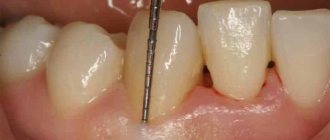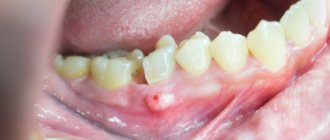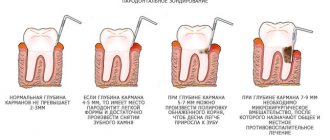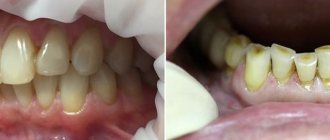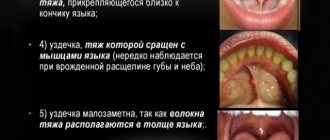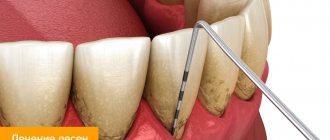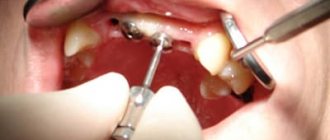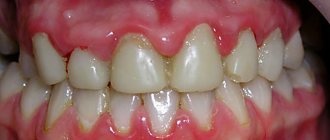Curettage in dentistry is a procedure for cleaning a cavity (for example, a periodontal pocket) from foreign matter, such as dental plaque, pieces of dead gum tissue, etc. Curettage is one of the important methods of treating periodontitis, but this method is also used in other cases. For example, after tooth extraction, curettage of the hole can be performed, which allows you to remove from the wound all the remains of the extracted tooth - fragments of roots, particles of filling material, etc. In essence, curettage is a surgical procedure, but in most cases, with the development of periodontitis and the formation of gum pockets, this is the only method that allows you to remove from the roots of the tooth everything that provokes the proliferation of microbes that destroy the attachment of the tooth to the bone - and stop the development of the disease.
How to do curettage
Curettage is a surgical operation.
Plaque, stone, and pathological tissue are removed from the periodontal pocket. If necessary, osteoplastic surgery is performed. This is necessary if bone resorption has already begun. Curettage must be carried out in the treatment of periodontitis and periodontal disease, as this is one of the most effective methods for eliminating inflammation in the gums. According to the technology of the procedure, there are two types of it:
- Open;
- Closed.
Indications and contraindications for surgery
Curettage is indicated for:
- mild (closed method) and moderate periodontitis (open method);
- some forms of gingivitis, accompanied by abundant subgingival deposits;
- absence of bone pockets.
Since curettage is a type of surgical intervention, it has a number of restrictions on its use in patients with severe systemic diseases, as well as under some unfavorable conditions that prevent operations in the oral cavity.
Contraindications related to the condition of local tissues include:
- discharge of pus from the gums;
- severe gum atrophy, thinning or changes in the walls;
- high tooth mobility;
- infectious lesion of the mucous membrane.
Contraindications related to general condition:
- bleeding disorders, diabetes mellitus (laser technology is recommended instead of standard technology);
- diseases of the cardiovascular system in the stage of decompensation;
- mental illnesses in which the patient is not able to adequately perceive the doctor’s manipulations during the procedure;
- feverish condition.
When visiting dentistry, before the procedure, diagnostic measures are required to select the optimal therapy and exclude contraindications to this treatment. Before carrying out a specific method of curettage of a periodontal pocket, a specialist will explain in detail what kind of cleaning method this is and give professional recommendations for the postoperative period.
Closed curettage
Can be used if the depth of the periodontal pocket does not exceed 5 mm, and pathological changes in the bones have not yet begun. When performing closed curettage, pathological tissues are exposed to ultrasound and hand instruments in the form of hooks, with the help of which granules are removed from under the gums. There is no cutting of the gums, so the procedure can be considered more gentle.
Flaws:
- The doctor performs the operation almost blindly; he does not see the subgingival space. Therefore, it is not possible to thoroughly clean the periodontal pocket in all cases.
- There is a risk of incomplete cleaning. Success largely depends on the experience of the dentist performing the procedure.
Due to its characteristics, closed curettage is suitable for mild to moderate periodontitis and periodontal disease. Sometimes it becomes the only possible method, since others cannot be used for some reason.
Flap surgery and curettage: price 2022
So how much does curettage of periodontal pockets cost in mid-price clinics in Moscow? For closed curettage, the price will start at an average of 700 rubles per tooth. Carrying out closed curettage with a laser will be slightly cheaper and will cost from 500 rubles per tooth.
The cost of open curettage for a segment of 6-7 teeth will be about 14,000 rubles (including the cost of economy-class bone material). The cost for each tooth starts from 1,500 rubles, but this price does not include the use of bone material. As for flap surgery, a segment of 6-7 teeth will cost you about 18,000 - 20,000 rubles, taking into account the cost of economy-class bone material.
Open curettage
Used if the depth of periodontal pockets is more than 5 mm. This is a surgical intervention, but compared to a closed one, the effectiveness is much higher. Since open curettage requires cutting into the gums, the operation is performed under anesthesia.
Stages:
- The doctor cuts the gum and peels it away from the tooth. After exfoliation, the tooth root is completely exposed. The dentist gets full access to the bone tissue.
- Cleaning and antiseptic treatment. The roots are cleaned of accumulated plaque and stone and polished using a burr and special pastes. After this, the tissues are treated with an antiseptic.
- Osteoplasty. This stage is not always necessary. With advanced periodontal disease, bone resorption gradually begins around the teeth, which will lead to loosening and tooth loss. In order to restore the bone, osteoplastic material is implanted.
- Suturing. After plaque removal, the gingival flap is returned to its place and sutured. A bandage with an antiseptic solution is applied on top.
Open curettage is a more complex procedure, but more effective than closed curettage. The surgeon sees the entire subgingival space and has access to bone tissue. Therefore, the quality is very high; both plaque and granulation tissue are completely removed from under the gums.
If necessary, open curettage can be performed simultaneously with flap surgery. It is indicated if the gum tissue is loose and the gum contour is disturbed. Very often, with periodontal disease, the gums begin to overhang the teeth. This violates the aesthetics of a smile. During flap surgery, the dentist removes excess mucous membrane and then sutures the gum.
Deep curettage
Severe periodontitis is a serious pathology, accompanied by the presence of periodontal pockets deeper than 5 mm, in which bone pockets often appear. With such signs, more extensive interventions are indicated to cleanse subgingival deposits, especially if the lesion has spread to a large number of teeth. The large depth of the gaps between the gums and the tooth root requires visual control to completely remove the pathological contents, so a radical operation is performed with peeling off a flap of tissue in the area of half or the entire jaw to the depth of the lesion.
After exposing the roots, they undergo deep treatment: removal of epithelial growths, any deposits, affected cement, as well as altered bone tissue. The treated area is washed with antiseptics and stitches are applied. In the presence of severe bone loss, osteoplastic materials are used to promote regeneration. Healing of oral tissue continues for a month.
Rehabilitation
Curettage of periodontal pockets is a surgical operation, after which there will be a period of rehabilitation. Following the recommendations will speed up gum healing, make it less uncomfortable, and avoid complications.
Oral care rules depend on the method:
- Closed curettage. Immediately after surgery, you should not eat for several hours. On the first day, it is better to refrain from brushing your teeth with a brush and toothpaste, replacing it with rinsing. During the entire rehabilitation period, you need to monitor your diet - exclude solid foods and foods containing dyes. After curettage, there may be increased sensitivity of the teeth and gums. A special paste that your doctor will recommend will help you remove it. It is imperative to rinse your mouth with solutions of strengthening and anti-inflammatory medications.
- Open curettage. Since this surgery requires cutting into the gum, recovery takes longer. Recommendations for the first 1-2 days after surgery are the same as for closed curettage. It is very important to minimize the possible stress on the gums and teeth. It is advisable to reduce physical activity at first. Until the stitches heal, your mouth should be rinsed with solutions of antibacterial and anti-inflammatory agents. This will help speed up healing and tissue regeneration.
Laser curettage
Dental pockets can be cleaned using a laser device. Instead of curettes and scalers, manipulations in the periodontal pocket are carried out using a diode or erbium laser beam. The procedure is prescribed for mild periodontitis. Using a dental laser attachment, the doctor inserts a beam into the space between the gum and the surface of the tooth root. When a laser acts on pathological growths (granulation tissue), they coagulate - destruction under the influence of high temperature and evaporation. An important feature of the technique is the absence of bleeding during curettage of periodontal pockets with a laser, which is due to the instant cauterizing effect of the beam.
To better eliminate pathogenic flora, the laser method is combined with photodynamic therapy. To do this, before the procedure, the gums and pocket area are treated with a preparation based on chlorophyll, a plant pigment. Its molecules accumulate in periodontal cells affected by microorganisms and form photosensitizer compounds. Half an hour after applying the pigment, the doctor acts on the colored tissue with a visible spectrum laser, which activates the resulting photosensitizers. The compounds destroy bacterial cells and elements affected by them, actively releasing oxygen. Since the chlorophyll in the drug has a selective effect, the laser does not affect healthy tissue. According to patient reviews, the procedure is almost painless; a tingling sensation may be felt.
Advantages of the laser method:
- low risk of gum injury;
- fast healing;
- no bleeding.
Laser cleaning is the method of choice for a group of patients who have contraindications to standard curettage methods - patients with diabetes mellitus, serious cardiovascular diseases, and bleeding disorders.
Flaws
Gum curettage is a simple dental operation with good results. However, it is not without its drawbacks:
- Traumaticity. Like any surgical intervention, curettage injures soft tissue.
- The need for anesthesia. Normally, the operation is performed under local anesthesia. Sedation or general anesthesia is used in extreme cases or when the patient is in panic.
- Rehabilitation. The gums heal quickly, but at this time it is necessary to follow the recommendations and take care of the oral cavity. Infection of the wound can lead to complications.
Curettage of periodontal pocket
Curettage is an outpatient dental operation - gum cleaning, which involves removing pathological gum pockets from tartar and soft bleeding tissues that grow during chronic inflammation of the gums around the neck of the tooth.
At the first signs of gum inflammation, you should contact a dentist, who, depending on the severity of the situation, will offer either professional teeth cleaning or surgical intervention: - closed curettage of the gums; — open curettage of periodontal pockets; - flap surgery.
If the patient comes in on time, before deep changes have occurred in the gum pockets and the integrity of the sockets is not compromised, professional teeth cleaning to remove tartar is sufficient to improve the health of the gums. The doctor will remove hard and soft dental plaque using manual instruments or using an ultrasound or laser device.
When the depth of pathological pockets reaches 2 mm, superficial cleaning turns out to be ineffective, because without curettage it is impossible to qualitatively clean them from pathologically changed tissues, since curettage allows you to clean not only pathological pockets, but also tooth roots, and therefore stop the development of inflammatory processes.
Alternatives to curettage
Alternative technologies are suitable as prevention or in the early stages of pathology development. At the Zuub clinic they use:
- Comprehensive teeth cleaning. This is good prevention. It can be used as one of the stages of complex therapy, but not as an independent treatment. During cleaning, using ultrasound and a mixture of water, air and soda, tartar and plaque are removed from the surface of the teeth. You won't be able to empty your pockets this way.
- Treatment with the “Vector” device. A method for cleaning and disinfecting shallow periodontal pockets. In mild stages of periodontal disease, it can be used as an alternative to closed gum curettage, but it cannot replace open vector therapy. "Vector" is more effective than classic complex cleaning. It is based on a combination of exposure to an ultrasonic wave and a special suspension with abrasive particles. Since the ultrasonic wave is applied vertically, it penetrates deeply under the gum. In addition, ultrasound has a good disinfecting effect. Thanks to this, with a small depth of periodontal pockets and an undeveloped pathological process, it can give a good result.
The periodontist selects the gum treatment technology based on the clinical picture.
Come for a consultation with a dentist at the Zuub clinic.
Content:
Around each tooth there is a small gingival fold, tightly adjacent to its cervical part, which is called a physiological periodontal (gum) pocket.
With poor dental care or due to hereditary factors, soft plaque accumulates on the teeth, which, under the influence of microflora, turns into hard dental deposits - stones.
Tartar, accumulating on the tooth wall, pushes back the gingival fold, forming a pathological gingival pocket, which causes gum inflammation and bleeding. As a result of inflammation, bone tissue is destroyed, gums swell, bad breath appears, ligaments around the teeth are destroyed, teeth lose support, begin to loosen and eventually fall out.
Results of cleaning gum pockets
Provided that the correct treatment tactics are chosen in accordance with the severity of the disease, curettage brings good results:
- Reduction of periodontal pockets
- Relief of the inflammatory process
- Elimination of sensitivity of teeth and gums
- Elimination of bleeding gums
- Stabilization of mobile teeth
- Prevention of relapse of the disease
The effectiveness of the method has been proven by numerous studies. Our patients really report good results.
After treatment, maintenance therapy is extremely important - in order to avoid activation of the disease, you need to visit a doctor every 3-6 months for monitoring and professional oral hygiene.
FAQ
– When is it necessary to see a doctor for curettage?
If you regularly visit the dentist's office, the doctor will promptly indicate the need for surgery. When you visit the medical office only as needed, pay attention to the presence of inflammatory processes in the gums and the appearance of a large number of deposits on the surface of the teeth. Pain when chewing and bleeding during brushing are also likely symptoms of enlarged periodontal pockets.
Is it painful to do curettage?
Patients' concerns about pain during this procedure are completely unfounded. Open and closed curettage is performed under local anesthesia. Anesthetics used in modern dentistry are effective and safe for human health. They are well tolerated by patients (with rare exceptions). Some people are allergic to certain types of pain medications. Therefore, the doctor must find out whether the patient has a history of any allergic reactions before the operation begins.
Periodontist's recommendation: do not delay visiting a doctor if symptoms of periodontal disease appear. The sooner treatment is started, the faster your gums will be healthy. Do not be afraid of pain; during surgical procedures you will be provided with effective local anesthesia. The branches of our clinic use only health-safe anesthetics that have been tested in leading clinics in the world.
The network of dental clinics “Smile” offers gum curettage services. Contacting our branches has a number of significant advantages:
- treatment is carried out by highly qualified doctors;
- all surgical and dental procedures comply with international standards;
- We provide family and cumulative discounts;
- pricing for our services is transparent to patients;
- We work according to a schedule convenient for you: every day until 21:00 (on Sunday until 16:00).
You can make an appointment at any of the branches of our clinic in Moscow, located within walking distance from metro stations:
- Alekseevskaya (VDNKh district, etc. Mira), address: st. 3rd Mytishchiskaya house 3, building 2;
- Shelepikha, address: Shelepikhinskaya embankment, building 34, building 1.
The modern equipment of the clinic and the experience of our doctors allow us to effectively and painlessly perform gum curettage, regardless of the severity of the disease. We guarantee the effectiveness and safety of treatment. We will keep your gums healthy!
Indications for curettage:
- feeling of tension (pulsation, bloating) in the gums;
- putrid odor from the mouth that does not disappear after brushing your teeth;
- swelling, redness and soreness of the gums;
- bleeding gums under any impact, including while brushing your teeth;
- tooth mobility;
- increase in interdental spaces;
- deposition of tartar under the gum;
- destruction of periodontal tissue and jaw bone tissue (formation of replacement tissue in their place).
Curettage has contraindications. The procedure is not performed if the pocket depth is more than 6 mm, there is an abscess and pus in the periodontal pocket, as well as with thinned gums affected by fibromatosis. Obstacles to curettage include tooth mobility of degrees III–IV, infectious diseases (influenza, tonsillitis, acute respiratory infections) and any diseases in the acute stage.
Prices for curettage
| Service | Price |
| Consultation + treatment plan | For free |
| Open | 1,200 rub. |
| Closed | 850 rub. |
Expert of the article you are reading: Kubasova Natalya Vyacheslavovna Orthodontist, leading specialist of the NovaDent network
15 years
Clinical experience
Otradnoe
st. Khachaturyan, 7
+7 +7
Free consultation with this specialist
Causes of periodontitis and its consequences
Many people are too negligent about oral hygiene. This leads to the fact that plaque and hard deposits begin to form on the teeth, indicating the appearance of the first signs of periodontitis. These processes are accompanied by bleeding and inflammation of the gums. The primary signs of the development of periodontitis also include tooth mobility and the appearance of purulent discharge from under the gums.
Subsequently, the soft plaque on the teeth mineralizes and becomes tartar, which promotes the release of toxins. These, in turn, cause gum inflammation and other adverse consequences.
Such consequences, first of all, include the gradual resorption of bone tissue around the tooth. In its place, granulation tissue appears, which contains many microbes that absorb the bone. This process contributes to a significant acceleration of bone tissue atrophy.
Another unpleasant consequence is the formation of periodontal pockets. They represent an area with destroyed bone tissue and a cavity that is filled with granular tissue, pus and dental plaque. To detect this pathology, x-rays or probing are required. It is worth adding that the periodontal pocket is often called the dental or gingival pocket.
Identification of a deep periodontal pocket (from 3 mm) means that the patient will no longer be helped by drug therapy. This is due to the fact that the destruction process has already taken an irreversible form.
The ineffectiveness of drug and therapeutic treatments can be explained by several reasons:
- Even the most qualified doctor cannot guarantee the removal of all subgingival deposits by inserting an ultrasonic tip under the gum. The lack of confidence in the 100% result of therapy is due to the fact that no specialist will be able to control what is happening in the periodontal pockets. That is why a large amount of destructive sediment remains there.
- This procedure is considered quite labor-intensive and expensive. However, it does not guarantee complete elimination of the problem.
- If the specialist manages to completely remove all subgingival deposits from the pocket, favorable conditions for the development of periodontitis will still remain in the oral cavity. Therefore, even removing all deposits will not stop the progression of the infection.
In such situations, the only effective treatment option is surgery. Only in this case will the removal of all subgingival deposits, granulation tissue and periodontal pockets be ensured.
Surgical methods for treating periodontitis
There are 3 main methods of surgical treatment of this disease:
- open curettage;
- closed curettage;
- flap surgery.
Indications
Prescribing curettage is possible only after a specialist has carried out diagnostic studies, including fluoroscopy. Based on the results obtained, the doctor will determine the required volume of intervention, choose the method of curettage, and draw up a treatment plan. Common indications for the procedure:
- inflammatory processes;
- abundant hard deposits leading to displacement of natural tissues;
- detected deep periodontal pockets;
- unstable dentition.
How open curettage is done at the Grandmed St. Petersburg clinic
Cleaning periodontal pockets with peeling off part of the mucous membrane is a full-fledged surgical operation that requires thorough preparation. In addition to radiographic diagnostics, blood is given for a general analysis - this will help identify contraindications associated with the presence of chronic diseases and prevent the development of complications in the postoperative period.
Operation stages:
- Preparation . The patient undergoes professional dental cleaning of the oral cavity with ultrasound, after which anti-inflammatory therapy is prescribed, and, if necessary, splinting. Immediately before the procedure, the oral cavity is treated with an antiseptic solution.
- Anesthesia. Open curettage is done under local anesthesia. Pockets up to 6 mm deep can be treated; up to 8 teeth can be treated in one session.
- Operation . The mucous membrane in the area of the necks of the teeth is cut along the upper points of the interdental papillae and, to gain access to the roots, is peeled off to no more than the depth of the pocket. If the edge of the gum is severely deformed, the incision site is slightly shifted, and the resulting strip of mucous membrane is removed at the end of the operation, since due to structural changes it will no longer be able to fit tightly to the neck of the tooth. The surgeon carefully cleans the surface of the roots from stones, and the gums from pathologically altered tissues (granulation tissues and epithelium grown into the pocket). The cleaning is completed by polishing the supra- and subgingival surfaces of the teeth with special attachments. In case of large losses of bone tissue volume, an osteogenic preparation is injected into the pockets to compensate for it. All manipulations are carried out under the visual supervision of the surgeon; hand instruments (curettes and scalers) are used during the procedure.
- Stitching . The wound is sutured in the area of the interdental papillae. If during the operation a flap of deformed gum was cut off, the mucous membrane is pulled up to the necks of the teeth, fixed and a protective bandage is applied with anti-inflammatory drugs (according to indications).
- Removing stitches. This manipulation is usually performed after the gums have completely healed, that is, on the 10th day after surgery. Complete restoration of the gums after open curettage should be expected 2–3 months after surgery.
